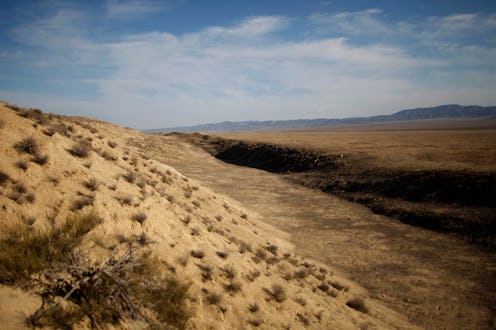News
What Does The San Andreas Fault Even Do?
As much as we would all like to just accept that Dwayne "The Rock" Johnson could indeed fight the San Andreas fault and defeat an earthquake with just his raised eyebrow and amazing biceps, it's always good to know the real science behind Hollywood blockbusters, because (SPOILER ALERT) sometimes they stretch the truth for dramatic effect. So what does the San Andreas fault really do?
Could an earthquake in California be so strong that it would actually be felt on the East Coast, as one character says in the movie San Andreas? Is it possible an earthquake near San Francisco could cause a tsunami that would engulf the Golden Gate Bridge, as depicted in another scene? Is it realistic to expect the earth to literally crack open after an earthquake? I'll make a deal with you: Read about the science of the San Andreas fault, and you'll be rewarded every few paragraphs with a photo of The Rock. No cheating and scrolling ahead now, because we're going to learn some geology.
First, what is the San Andreas fault, and what exactly is it capable of? According to the U.S. Geological Survey, the earth's crust is separated into plates, and when two plates meet at the fault shift, the resulting vibrations are what people on the surface experience as an earthquake. Two of the earth's plates meet along the coast of California. That's the San Andreas fault, which is 800 miles long and at least 10 miles deep.
You know California is earthquake country, but could a quake along the San Andreas really produce a tsunami? Experts from the California Geological Survey say probably not, according to the Los Angeles Times. While the San Andreas fault can produce earthquakes that register a 8.0 magnitude on the Richter scale, the fault is actually too far inland for a quake to result in a tsunami.
That doesn't mean tsunamis off the California coast aren't possible, but experts told the LA Times the most serious tsunami threat for the west coast would come from a large quake up in Alaska. In that scenario, residents of coastal California would have several hours' warning a tsunami was on the way. Alaska holds the record for the largest earthquake ever recorded in the U.S., at a magnitude of 9.2, according to USGS.
Could an earthquake really open up a crack in the earth? USGS said though a gaping rupture is a convenient plot twist in earthquake movies, but the ground actually moves across a fault during a quake, not away from it. If the fault opened, there wouldn't be the friction required to cause an earthquake in the first place.
TL; DR — No, the earth won't split open in an earthquake.
Is it possible for an earthquake in California to be felt as far away as the East Coast? Despite what Paul Giamatti warns about in the movie, USGS said a "mega-quake," which means one that registers a 10.0 magnitude or higher on the Richter scale, is very unlikely (even though it is theoretically possible). That's because the length of the fault determines the strength of the quake. USGS said there are no known faults on Earth that could produce a 10.0 or stronger earthquake.
When you watch The Rock fly his helicopter around California and rescue people in the movie San Andreas, now you'll know what's real and what's not. But just because there may be more fiction than fact in the film, that doesn't make those biceps any less impressive.
Images: Getty Images (2)
